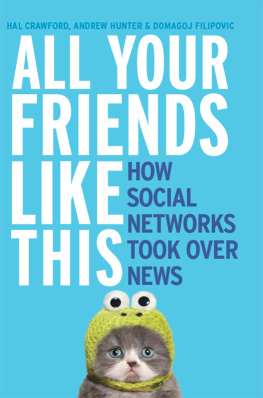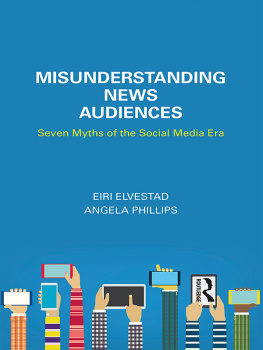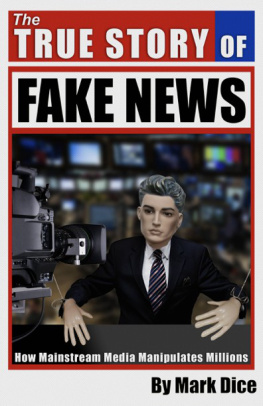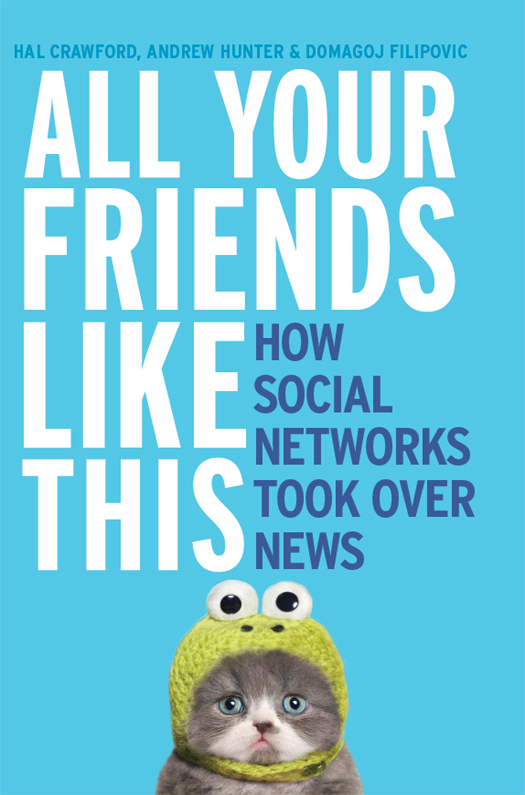Contents
Guide
23 people who helped with this book restored our faith in humanity:
Rachel Hynes (for love, guidance and killer copy editing)
Tina Filipovic (for the love, support and proof reading)
Iris Huizinga (for patience and unswerving belief)
Shaun Davies (the fourth member of Share Wars, for shaping early thinking)
Brigid Delaney (for help in navigating the literary world)
Tim Dunlop (for truly believing)
Paul Colgan (for media insights)
Sean Maher (for mostly constructive criticism)
Jenny Duxbury (for the fervour)
Natalie Sutton (for spreading the Like)
Antonia Christie (for opening doors)
Fiona Inglis (for awesome representation and understanding)
Mary Rennie (for fearless editing prowess)
Catherine Milne (for knowing how to handle fragile egos)
Benjamin Stevenson (for stress-testing the material)
Emma Dowden (for the proofing and the pain we had to have)
Rory Kinsella (for the wisdom at the marble tables)
Emma Chamberlain (for making it real)
Henri Paget (for the Oracle, among many creations)
Marko Filipovic (for being wiser than you act)
Marica Filipovic (for proof reading and advice)
Matthew Janis (for testing our logic)
Andrew Banks (for a story)
There is a wonderful scene in Annie Dillards rambling book Pilgrim at Tinker Creek where she comes across a frog on the edge of the water one day. Dillard explains she has been getting better and better at spotting frogs, and delights in scaring them into the creek. This frog doesnt budge. Its a small frog, with wide, dull eyes. She manages to get within a few feet of it when she realises something else is at play. Something dark and weird. The frog begins to collapse.
The spirit vanished from his eyes as if snuffed. His skin emptied and drooped; his very skull seemed to collapse and settle like a kicked tent. He was shrinking before my eyes like a deflating football.
The frog had fallen prey to a giant water bug. This carnivorous insect dissolves its victims from the inside by injecting them with saliva, then sucking out the goop. The bug had been there, under the waterline, the whole time Dillard was sneaking up on the frog drinking the life out of it.
Most observers of news media share Dillards perspective. Digital platforms have been drinking the life out of traditional publishers from below the waterline, while the faade of their prey has remained more or less intact. Newspapers, radio and television stations still publish and broadcast to millions but the numbers are clear: in an era when advertising money is moving to digital, more than 50 cents of every digital dollar goes to Facebook and Google. Far from colonising digital, traditional medias share of the digital spend has in most cases stalled.
Those numbers have obscured the good that has come out of the shift in media power. All anyone cares about is how that poor frog is going to get on without any insides. Thats because the old media have more or less owned the discussion its been the guy with the wide, dull eyes talking. Its time to get below the surface and find out what is happening.
What you find below the waterline is a strange world where the predator-prey relationship is gone and weird forms of symbiosis emerge. Digital platforms dole out some of their massive bounty to content creators in order to ensure their own continued prosperity. Bedrock values like telling the truth are challenged. What people really value is laid bare.
What we do in this book is sketch one of the aspects of this strange world: the impact that social networks have on the type of news we consume. We invite you to come in. The water is lovely, despite the whiff of swamp.
A note on the structure of the book: each chapter has been written by one us Hal, Andy or Dom. We veer between the personal and the objective, but always we have tried to walk our talk by using examples. If you find yourself wondering why you are reading about starlets, monks or kids entertainment at any point, be assured there is method to the madness. The stories form the background and texture against which we have made our observations, and we can guarantee youll be engaged. The social network has seen to that. These are the worlds most likeable stories.
By Hal Crawford
There are two reasons you should care about social networks if you care about news.
First, sharing on social networks has become a major distribution mechanism for news stories. The digitisation of social networks has augmented a natural process and for millions of people their first exposure to information about the world comes from their friends, not directly from news media.
The second reason hinges on the first. Like all distribution mechanisms, social networks influence the content they distribute. It turns out that people on social networks prefer certain styles and types of content. The stories change and with them the tone and flavour of the newsmaking process are altered.
Social networks are one of the main drivers in a process that has seen the guts sucked out of traditional news outfits and sprayed all over the joint, allowing new players to spring up and different types of storytelling to flourish. They have made news better while opening the door to unprecedented abuses. Thats why this book matters, and why we have done everything we can to find out what makes news stories share on social networks.
The good old days
Paul Murray edited The West Australian newspaper for the whole of the 1990s a neat decade. Halfway through his tenure I started at the paper as a cadet reporter.
The West began in 1833 as a colonial gazette. Tabloid in physical size, the mainstream paper of record for the city of Perth had managed to outlast or outcompete all its rivals, so that by the 1990s we were the only show in town. Everyone said we had distribution stitched up the newsagencies, the subscriptions, and the army of trucks and planes needed to get that paper to the whole state. Western Australia is massive three-and-a-half times the size of Texas and we had early deadlines for the state editions to get out and onto planes heading north. You filed a story at 7pm and someone would be reading it at 6am the next day 2200 kilometres away in Kununurra. The effort involved in printing and shifting those physical papers was immense, almost heroic, and now it all seems like the labour of ants.
The West had a culture that I now know is common to newspapers across the world. I started fresh from university, so I had to be reprogrammed: I had to stop writing to make myself look smart and start communicating. There is something wonderful in newspaper culture, for those not acquainted with it; something valuable in the wisdom created by innumerable interactions with society at every level. Everything was honed for clear communication and fast production: the concept of a style guide, arbitrary but inviolable; the way subeditors tore your copy up and stitched it back together; and above all, the knowledge of what made a good story. After years of trying to guess what university professors wanted to hear, I lapped it up: certainty and reality. Progress at the paper centred on the story, and in the craft of its creation there was a well-founded clarity. Nice yarn was the highest praise possible.
All this rested on a typical newspaper hierarchy. At the bottom were the cadets, then the reporters and subeditors, the senior reporters or roundsmen, the chief of staff, the back bench editors, section editors and, above them all, the editor. Position in the hierarchy corresponded to who knew stories best the editor was the ultimate judge of story.









